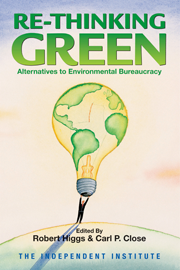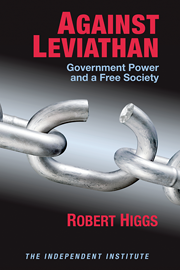For the greater part of the twentieth century, mainstream economists viewed negative (technological) externalities as a prima facie justification for government intervention in the market. Absent such government action, they argued, nothing would be done to prevent or remedy the damages suffered by third parties as a result of unrestrained “spillovers” or “neighborhood effects.” For example, in the words of Joseph E. Stiglitz (1988, 76), “without government intervention there would be an underprovision of pollution control.” Even such staunch defenders of the market as Milton Friedman (1962, 30) and F. A. Hayek (1979, 43-45) conceded that spillovers might justify government intervention, although they embraced neither the “blackboard economics” conclusion that government intervention is desirable and effective in all cases of spillovers nor the “nirvana” standard implicit in Stiglitz’s use of the orthodox term “underprovision.”
Not until the argument of Ronald Coase’s 1960 article “The Problem of Social Cost” began to penetrate the profession’s understanding did economists start to appreciate how private contracting—usually viewed as property-right exchanges of various sorts—might be employed to prevent or remedy negative externalities without any government intervention to impose regulation, taxes, or subsidies. Gradually, a literature has developed in which an assortment of cases—private construction and maintenance of lighthouses (Coase 1974), private provision of bee-pollination services (Cheung 1973), private management of coastal development (Rinehart and Pompe 1997), private improvement of riverine water-quality (Yandle 2004)—illustrates the voluntary internalization of externalities in history.
Even now, however, more than forty years after the publication of Coase’s landmark article, economists and economic historians continue to learn about important cases of private contracting to allay pollution problems and, in particular, about the variety of means that private contractors have employed to organize themselves for this purpose and to carry it out. In the present article, I relate the history of an important and little-known case, the voluntary measures that mine, mill, and smelter operators undertook in the Coeur d’Alene mining district beginning at the turn of the twentieth century. These parties not only purchased existing private property rights specifically in order to internalize negative externalies, but they engaged in creative organizational and technological innovation to achieve the same end. They did not do so, however, merely out of the goodness of their hearts. The interplay between legal and political proceedings, on the one hand, and the operators’ “internalization” projects, on the other hand, lies at the heart of the story.
The Fabulous Coeur d’Alene
The Coeur d’Alene mining district is located in the Idaho panhandle approximately 300 miles east of Seattle and 70 miles east of Spokane. Mining began there after the discovery of gold near the North Fork of the Coeur d’Alene River in 1883 kindled a gold rush that brought thousands of people in search of quick riches. The town of Murray sprang up, “a city a half a mile long” that “had its own lawyers, doctors, gamblers, and women of ill repute” (“Coeur D’Alene Mining District” 1998). By 1885 the rush had subsided, but gold mining continued near Murray for decades afterward. As prospectors fanned out from the original gold rush on the North Fork, they discovered mineral deposits rich in silver, lead, and zinc near the South Fork of the river in 1884, and those deposits became the basis for the development of one of the world’s greatest mining districts, known nowadays as the Silver Valley (Ojala 1972, 6-8; Bennett, Siems, and Constantopoulos 1989, 145; Bennett 1994, 6).
According to an authoritative summary published in 1989,
-
The Coeur d’Alene Mining District . . . has the largest recorded silver production in the world. From the beginning of lode mining in 1884, the district’s mines have produced over 1 billion ounces of silver, 8.5 million tons of lead, 3 million tons of zinc, and substantial quantities of antimony, cadmium, copper, and gold. The total value of this production is over $4.8 billion . . . .
There are over ninety mines in the district. Eleven of these have produced over 3 million tons of ore. Of mining operations in the United States, the Coeur d’Alene contains the largest underground mine (the Bunker Hill, over 150 miles of workings), the deepest mine (the Star-Morning, over 7,900 feet deep) and the richest silver mine (the Sunshine, over 350 million ounces of silver). (Bennett, Siems, and Constantopoulos 1989, 137)
Almost all of these mines are located near the South Fork of the Coeur d’Alene River or its larger tributaries, including Canyon Creek, Nine Mile Creek, Big Creek, and Pine Creek. This district occupies a roughly rectangular area approximately twenty-five miles long from east to west and five miles across from north to south. Figure 1 sketches the setting, including the larger towns and the major creeks (map taken from Bennett 1994, 7).

Figure 1. Location map of the Coeur d’Alene Mining District (Silver Valley) in Idaho, showing recently active mines.
Although the South Fork between Mullan and Pinehurst flows in some places through a sizable flood plain, its tributary creeks, along which most of the mines are located, all pass through steep, narrow canyons. The important mining town of Burke, on Canyon Creek, for example, was so narrow that “merchants had to roll up their store awnings or lose them to passing trains” (Bennett, Siems, and Constantopoulos 1989, 154), and the nearby Tiger Hotel accommodated itself to the narrow canyon by straddling the railroad track. (Unfortunate consequence: “lodgers were regularly smoked out of their rooms when wood-burning locomotives passed underneath” [Van Gundy 1998].) This feature of the topography had major consequences for the disposal of wastes from the mines and, more important, from the associated mills.
Mill Tailings and Their Disposal
The economics of mineral production requires that ores removed from the mine be concentrated nearby, to avoid the expense of transporting large quantities of worthless rock and nonmetallic material, or “gangue.” In the beginning, workers picked the mineral-laden chunks out of the crushed ore by hand, sacked them, and shipped them via a narrow-gauge railroad (completed in 1887) to the old mission at Cataldo, then by paddlewheel riverboat twenty-five miles to Lake Coeur d’Alene, and finally by steamer across the lake to the railhead for transportation to distant smelters. In 1890, completion of the Northern Pacific tracks through the valley and up Canyon Creek simplified the shipment of ores to the smelters (Bennett 1994, 6-8; Van Gundy 1998).
To further concentrate the ores, the mine operators soon employed a system of grinding and washing. As described by geologist Earl H. Bennett,
-
The ore-bearing rock was ground up and the heavy galena separated by gravity using equipment with names like jigs and buddles.
In a jig cell, a plunger agitated a mixture of ground up ore and water. Water flowing through the cell separated the less dense minerals from the galena. . . . The finer material (slimes) was processed using other gravity equipment called buddles or vanners. . . . Only about 75% of the ore was recovered in the jig plants . . . , but recovery from the slimes was far worse.
Obviously, the early gravity mills were very inefficient, reclaiming only part of the ore; the rest was dumped in the nearest creek along with just about everything else in the district . . . . This mill waste is called jig tails and this material was the first major metal contamination in the district. (1994, 8).
Periodic floods “would move the metal-bearing jig tails down the South Fork system and the tails would eventually reach Smelterville Flats” near the west end of the valley, but “fortunately the coarsely ground, dense ore, did not transport easily, and few of these jig tails made it past the flats” (Bennett 1994, 9).
Just before World War I, the mills began to adopt a new concentration technique known as “flotation” or, in a later, more complicated version, “selective flotation.”
-
It was discovered that if air was blown through a mixture of very finely ground ore, water, and special chemicals, the sulfide minerals would cling to the bubbles and the resulting froth could be skimmed off, recovering most of the metal in the rock. The new technology not only greatly increased ore recovery . . . but now different ore minerals could be separated from each other. For example, zinc, which had been a detriment to earlier mining efforts, could be separated from lead, and a whole new industry was developed to exploit the characteristics of this metal. (Bennett 1994, 13)
Although selective flotation allowed the mill operators to increase their recovery of valuable metals from the ore, it also required finer grinding of the ore, in a ball mill, than the stamp mills used in the earlier technique had produced, and the resulting waste product—known as “mill tailings” or “slimes”—migrated more readily once it had been discharged into a creek or into the South Fork itself. “This more mobile material migrated into the lateral lakes between Cataldo and Lake Coeur d’Alene and, eventually, into the big lake itself” (Bennett 1994, 15; see also Ellis 1932, 28-30, 117-18).
Legal Challenges and Coasian Responses
Impoundment Dams
Had the terrain been more suitable, the mills might have disposed of their wastes in nearby impoundments or “tailings ponds.” Apart from the expense of building and maintaining such ponds, however, the space simply did not exist at most sites (U.S. Bureau of Mines 1932, 29; Taylor 1933, 8). In any event, using the nearest waterway as a means of waste disposal hardly seemed remarkable at the turn of the twentieth century; indeed, at that time such usage was the rule for mining, milling, and industrial plants almost everywhere in the United States. As Nicholas Casner has observed, “flushing the residue of progress down the Coeur d’Alene River was considered an unfortunate but necessary function of industry” (1989, 7).
Because of the weight of the jig tails, much of it settled in the beds of the creeks or the South Fork, but periodic floods carried new tailings beyond the river banks and flushed some of the old tailings sediments along with them. The buildup of tailings in the waterways, including the formation of tailings bars here and there, reduced the carrying capacity of the creeks and the river’s main channel and made them more susceptible to flooding. By 1900, farmers, especially along the lower reaches of the river, were complaining that such overflows poisoned their crops and livestock (Casner 1989, 19-20; Bennett 1994, 10; U.S. Bureau of Mines 1932, 6).
Even earlier, in 1889, the mine owners had formed an association to deal with matters of joint concern, especially the turbulent labor relations for which the district became infamous (Bennett 1994, 10). Soon after the turn of the century, the Mine Owners Association undertook to deal with the spillovers that threatened to expose them to costly legal judgments for damages to farmland and other property. Their immediate response involved using technology (for containing the spread of emissions) to fight the technology (of the milling process with its inherent spillovers of tailings).
The mine operators first built several small impounding dams on Canyon Creek, Nine Mile Creek, and the South Fork above Wallace. “Some of these dams were solely for impounding and storing tailings and some for diverting water for power and milling purposes, [and the latter] also collected and held back a certain amount of debris” (“Mining Industry” n.d., 1). Then, between 1901 and 1903, the operators built three substantial wooden dams specifically for the containment of tailings: across the mouth of Canyon Creek at Woodlawn, across the South Fork below Osburn, and across the South Fork farther downsteam at the end of Smelterville Flats, below Kellogg (Bennett 1994, 10). To accommodate the storage of debris and the spread of water behind these dams, the operators purchased some 2,300 acres of land (McCarthy et al. v. Bunker Hill & Sullivan Mining & Concentrating Co. et al., 164 F. 927, at 933-34). Although these dams prevented great volumes of tailings from moving farther downstream, they did not stop spillovers of the finest slimes, and they were vulnerable to overflow and damage during periodic floods. During a flood in December 1917, they suffered substantial damage, with a consequent large spillover of tailings (Bennett 1994, 10, 12; Casner 1989, 26-27; U.S. Bureau of Mines 1932, 6).
In 1904, motivated in part by fear of lawsuits that might be brought by farmers subject to tailings spillovers, operators of the Page Mine and the Bunker Hill Mine, located near the west end of the valley, where it is wider, constructed tailings ponds to impound their mill wastes—the first such impoundments in the district. The Bunker Hill & Sullivan Company built another, larger impoundment pond in 1928 (Casner 1989, 26; Bennett 1994, 12). These ponds ultimately came to contain huge quantities of tailings, which were later reprocessed with superior milling techniques or used for other purposes (Casner 1989, 27; Bennett 1994, 11). Some 2.6 million tons of tailings were removed from the Bunker Hill impoundment area and used to build the roadbed for construction of Interstate Highway 90 near Kellogg in the 1960s (Higgs 2000, 11-13).
Land Purchases and Pollution Easements
Construction of the dams early in the twentieth century failed to head off all lawsuits against the mining companies. In 1903, Josiah Hill, a Shoshone County farmer brought a $12,000 damage suit against the Standard Mining Company, which operated a mine and mill on Canyon Creek above Wallace. At trial, the company defended itself by appealing to the state constitution, which contained the following provision: “in any organized mining district, those using the water, for mining purposes or milling purposes connected with mining, shall have preference over those using the same for manufacturing or agricultural purposes.” The court ruled in favor of the defendant and awarded Standard its court costs. After the case was appealed, the Idaho Supreme Court, in the landmark case Hill v. Standard Mining Co. (12 Idaho Reports [1906]), reversed the ruling but awarded the appellant only his costs of appeal. Notwithstanding the company’s plea that a finding for the complaintant would have dire consequences for the entire mining industry of the Coeur d’Alene district, the supreme court ruled that “deplorable as this [outcome] might be—if true—it furnishes no excuse for the court to shirk its responsibilities” to protect the rights of all parties; although the constitution granted mining and milling enterprises a preference in the use of water, that preference did not entail a right to deposit in the waterways “debris and poisonous substances to the injury of other users of water” (Casner 1989, 27-29, quoting Idaho constitution and Hill v. Standard Mining).
While this case was making its way through the courts, sixty-five Kootenai County farmers brought a suit seeking more than $1.2 million in damages against Bunker Hill & Sullivan and three other mining companies in 1903 in the U.S. district court. (Kootenai County includes the area through which the Coeur d’Alene River flows between Calaldo and Lake Coeur d’Alene, whereas the mining district itself lies in the adjacent county to the east, Shoshone County.) In a separate action, the plaintiffs sought a permanent injunction against emissions into the river by the defendants’ mines and mills pending resolution of the damage suit. In 1906, the federal district judge, having personally inspected the areas involved in the case in 1905, found that the preponderance of the evidence did not justify the issuance of an injunction, and he ruled that the complaintants “should rely upon the recovery of such damages as they have suffered” (McCarthy et al. v. Bunker Hill & Sullivan Mining & Coal Co., et al., 147 F. 981, at 984). The circuit court of appeals upheld this decision in 1908 (McCarthy et al. v. Bunker Hill & Sullivan Mining & Concentrating Co. et al., 164 F. 927). The damage suit ended abruptly two years later, when in August 1910 “in a directed verdict, the jury awarded the sixty-five farmers one dollar” (Casner 1989, 34).
Although the companies won the foregoing cases, they had good reason to fear that other costly court actions might be brought against them in the future. After all, as the judge had declared in Standard Mining, even though the miners enjoyed a constitutional preference in using the state’s water, no one had a right to emit into the waterways “debris and poisonous substances to the injury of other users of water.” Therefore, to provide protection against the costs and uncertainties of possible additional lawsuits, the mine owners decided to adopt a new strategy. “In 1910 a program was started to indemnify all property owners in the South Fork of the Coeur d’Alene River valley against possible damage from overflow, and from there on down the main valley of the Coeur d’Alene River . . . to the lake” (“Mining Industry” n.d., 2).
-
In most instances releases were purchased for all past damage if any with easements for the future. In some instances easements were granted for dike construction, in other cases land was bought outright. Actual overflowed land was not the only acreage included in these settlements but any land which was definitely threatened. Many entire subdivisions were included, a substantial portion of which were [sic] well above the high water mark; it was not the practice to deal with fractional lots, but rather to include with the whole unit all of a subdivision if any of it was subjected to overflow or threatened. (“Mining Industry” n.d., 2)
The member companies of the Mine Owners Association shared the costs of these purchases of property rights according to their share of the group’s entire tonnage milled. Such purchases continued at least into the 1930s.
In the late 1930’s, an accounting of the costs incurred in these property-right acquisitions stated that “there has been expended in this undertaking for the securing of easements, for settlement of alleged past damages, for purchase of land outright, for legal, claim agent and other expense, and for various collateral outlays a total of $722,383.37. There was dealt with on one or other of the above basis 25,944 acres of land” (“Mining Industry” n.d., 2). The acquired property rights attached to “practically all land abutting on the South Fork of the Coeur d’Alene River, and the main river to the lake, and in addition such areas as may be possibly effected [sic] or threatened by high water or overflow” (“Mining Industry” n.d., 2-3). According to the auditor of Kootenai County, 11,315 acres of land in that county alone were under easements in 1932 (U.S. Bureau of Mines 1932, 8).
The easements “released the mines from all past and future pollution damage claims” and applied to “damage to crops, sickness, disease, or death to domestic animals” that mining and milling operations might cause (Casner 1989, 41, citing an indenture entered in 1913).
Although the mine operators continued to face lawsuits episodically from the 1910s through the 1930s (for a review of these legal actions, see Casner 1989, 45-49; see also Taylor 1933, 3-5), the acquisition of property titles and easements substantially released the operators from liability for spillovers caused by the deposit of mill wastes in the river and its tributaries. By 1940, “court cases in the Coeur d’Alenes were out of the question, as the mines had sufficiently protected themselves behind the easement barrier” (Casner 1989, 99). Not all the negative externalities had been internalized, but a great many had been—along thoroughly Coasian lines. As the leading historian of the matter has observed, “the easements appear to have been a carefully weighed business decision designed to minimize a potential expense” (Casner 1989, 116).
In 1917, Bunker Hill & Sullivan began operation of the first smelter in the Coeur d’Alene mining district. The smelter processed Bunker Hill’s own concentrates and acted as a custom smelter for the concentrates produced in other companies’ mills. Operation of the smelter added the negative externality of atmospheric emissions (including sulfur dioxide, zinc, cadmium, and lead) to the district’s existing spillovers associated with the emission of mill tailings into waterways. The company was aware of the legal and political difficulties that the Anaconda Copper Mining Company had encountered recently in connection with air and water pollution caused by its smelter at Anaconda, Montana (Bennett 1994, 12; for the Anaconda story, see Emmons 1996, 153-95). Following Anaconda’s example, Bunker Hill & Sullivan purchased smoke easements from landowners in the area beneath the smelter’s smoke plume. According to the U.S. Forest Service, by 1940, those easements attached to some 6,000 acres of private land (Casner 1989, 43-44). Purchases of smoke easements continued at least into the 1950s (Casner 1989, 45). Moreover, again following Anaconda’s example, the company arranged for a land exchange with the U.S. Forest Service, covering some 7,700 acres, to compensate for damage its air pollution might cause to trees on certain tracts of land previously within the national forest (Casner 1989, 42-45). Although no doubt some air-pollution spillovers continued, the company’s purchase of easements and its exchange of land titles with the government effectively internalized a great deal of the damage to property rights that otherwise would have occurred—again in a thoroughly Coasian fashion.
Political Challenges and Coasian Responses
In mining, milling, and smelting, as in politics, you can’t please all the people all the time. Notwithstanding the mining companies’ construction of impoundment dams and (in two places) tailings ponds and their purchase of land titles and pollution easements from private landowners, some parties continued to complain of uncompensated harm as a result of the companies’ emissions, especially the slimes reaching Lake Coeur d’Alene and, some charged, even beyond it, into the Spokane River (Ellis 1932, 118). Such perceptions of harm and related complaints received powerful amplification at the end of the 1920s, setting in motion political challenges that the companies would meet with even more creative responses.
In December 1929, John Knox Coe, city editor of the Coeur d’Alene Press, a newspaper published in the city of Coeur d’Alene, which is located at the north end of the lake of the same name, published the first of several articles that came to be known as the “Valley of Desolation series.” Coe described the pollution damage in the Coeur d’Alene district as well as the mine operators themselves in lurid terms (for example, “once a fruitful ‘paradise’—now the ‘valley of death’” and “sublime indifference of the octopus of heartless wealth”), and he called upon the state legislature to take regulatory action (Casner 1989, 51-54; Casner 1991, 7; Bennett 1994, 15-16). In 1930 the newspaper solicited support for its crusade from local civic and outdoor groups, including the Izaak Walton League. Republican and Democratic party organizations in Kootenai and Shoshone counties were drawn into the fray during the 1930 political season. “As the November, 1930, elections drew near and local political heat from the tailings problem intensified, the mineowners planned a course of action that would make environmental regulations seem superfluous” (Casner 1989, 59). Their action might well have been hastened when the state legislature on March 16, 1931, created the Coeur d’Alene River and Lake Commission to study the pollution problem and report back at the next legislative session, in 1933 (Casner 1989, 64). The commission enlisted the assistance of experts from the U.S. Bureau of Mines, the U.S. Bureau of Fisheries, and the U.S. Bureau of Public Health, thus bringing the federal government into involvement again (the first instance having been Bunker Hill’s land exchange with the U.S. Forest Service).
The Suction Dredge at Cataldo
In October 1931, the Mine Owners Association, after close consultation with the U.S. Bureau of Mines and extensive planning, began construction of a large floating suction dredge in the river near Cataldo, at a cost of approximately $100,000, and the dredge began operation in July 1932 (U.S. Bureau of Mines 1932, 29; Finch to Easton, June 4, 1935, copy in my possession). By 1934, the companies had invested $165,000 in this project; by 1968, when it ceased operation, some $2 million had been spent (Casner 1989, 82-83). According to a 1959 report, “Over the years, more than 23 mining properties have voluntarily contributed to the Dredge Fund [which the operators created in 1930] under a formula devised by the operators” (“Dredge on Coeur d’Alene River” 1959).
The electrically powered dredge, which was designed by W. L. Zeigler, an engineer employed by Hecla Mining Co., first excavated settling basins in the river bed. After tailings had formed a solid buildup in the basins, the dredge’s cutter boom pulverized the sediments, and a powerful pump sucked them out and propelled them through a large pipe to a holding area of more than 2,000 acres that the association had purchased on nearby Cataldo Mission Flats for the purpose of impounding the redirected wastes (U.S. Bureau of Mines 1932, 29; “Mining Industry” n.d., 3; “Dredge on Coeur d’Alene River” 1959). Water pumped out along with the tailings was returned to the river “through a series of ponds and sloughs” after the sediments had settled in the impoundment area. The dredge excavated as much as 3,000 tons of sediments per day (U.S. Bureau of Mines 1932, 29).
Although mine owner Lewis Grant surely exaggerated when he declared in a 1952 speech that the dredge system completely corrected the tailings problem and left the water “perfectly clear,” there is no doubt that the system did a great deal to remove tailings from the river. In 1951 an article in the Spokane Spokesman Review stated that the tailings deposited in the Mission Flats impoundment area covered 2,000 acres to a depth of twenty-five to thirty feet (Casner 1989, 83). Even historian Nicholas Casner, a consistent critic of the mine operators’ pollution-abatement efforts, admits that “construction of the dredge did improve the tailings situation to an extent because it allowed sediment the opportunity to settle out before the water returned on its path to the lake” (1989, 84). Toward the end of the dredge’s period of operation, in the late 1950s and early 1960s, the Mine Owners Association Dredge Fund contracted with the Idaho Department of Highways to direct the tailings into an area between two parallel dikes in order to construct the roadbed for Interstate Highway 90 west of Cataldo (“Dredge on Coeur d’Alene River” 1959; Bennett 1994, 17; Higgs 2000, 11).
If construction and operation of the dredge constituted an attempt to head off state regulatory action, it must be deemed to have succeeded. In 1933, “the Idaho legislature accepted the reports of the Coeur d’Alene River and Lake Commission and washed its hands of the matter” (Casner 1991, 19; for the separate report of one member of the three-member commission, see Taylor 1933). The state took no regulatory action until years afterward, and then only under pressure from federal legislation, such as the Water Pollution Control Act of 1948 and the Mining Waste Pollution Control Act of the same year. In 1933 the state, along with the rest of the nation, had reached the depths of the Great Depression, and no doubt many legislators in Boise doubted the wisdom of threatening the successful continuation of operations (and the consequent employment of thousands of workers) by the mine owners of the Coeur d’Alene district and their auxiliaries.
Tailings Ponds, High Stacks, and Reinsertion of Tailings
In the mid-1960s, under substantial pressure from state and federal governments, the mines that continued to operate—far fewer than in earlier days—constructed settlement ponds for their tailings (Casner 1989, 79, 137; Bennett 1994, 20). In addition, Bunker Hill & Sullivan built a remarkable 715-foot-high smokestack at its smelter and a 610-foot-high smokestack at its zinc plant near Kellogg to disperse their atmospheric emissions more effectively (Casner 1989, 139; Bennett 1994, 22). Even more interesting and relevant for present purposes, the mine operators began to pump tailings back into the mines to fill up mined-out areas, rather than directing those wastes into waterways, tailings dumps, or impoundment ponds (Bennett 1994, 18). This procedure, which became standard practice in the district, amounted to internalizing the externality not only in the economic sense but also in the literal sense.
Nowadays, only a few mines, at most, operate in the “fabulous” Coeur d’Alene mining district, and the industry that once nourished mining barons and provoked labor wars has become but a faint shadow of its former self. Bunker Hill’s smelter, electrolytic zinc plant (the first in the United States), other metallurgical facilities, and fertilizer plant shut down forever in 1981, terminating some 2,100 jobs. Although the Silver Valley constitutes a Superfund site that has given rise to vast and protracted legal wrangling, the area now advertises itself as a prime destination for recreationists, not for fearless and hard-edged underground workers.
Conclusions
Economists and noneconomists have different conceptions of pollution. The noneconomist supposes that whenever people emit some substance, usually a by-product or waste associated with producing or consuming goods and services, into the physical environment and thereby alter the preexisting natural state for the worse, that emission constitutes pollution. (Hence, not surprisingly, endless quarreling occurs about whether some alteration of the environment is actually “for the worse.”) For the economist, however, the distribution of property rights has prime importance: if I deposit wastes on my own land, I do not pollute—I hold the right to decide how the area will be used, for better or worse—but if I deposit wastes on your land without your consent, I do pollute.
Many of the areas despoiled along the Coeur d’Alene River or in the hills near Bunker Hill & Sullivan’s plants were either owned by the mine, mill, and smelter operators or subject to pollution easements for which those operators had paid the landowners. Spillovers of mill tailings or sulfur dioxide onto these areas do not constitute pollution in the economist’s conception. Geologist Earl Bennett verged on this perspective when he observed: “Were the companies aware that they were creating a problem? Undoubtedly, but they had legal and acceptable ways of handling the issues. These methods may be unacceptable to us today, but they were standard for their time” (1994, 20). “Their time,” we might note, was one in which private property rights and the common law still carried the day, whereas “our time” has embraced extensive government command and control to deal with such matters.
The facts of the case considered here, however, are beyond dispute: absent either government regulation or the imposition of Pigovian taxes and subsidies, the mine, mill, and smelter operators undertook a variety of actions to internalize negative externalities. They organized themselves for collective action, creating and maintaining first the Mine Owners Association and four decades later its offspring, the Dredge Fund. Together, they constructed large dams to impede the passage of mining wastes down the creeks and the South Fork. Together, they purchased private lands and pollution easements covering thousands of acres at great joint expense. Together, they designed, constructed, and for thirty-six years operated the ingenious suction-dredge system at Cataldo. Ultimately, after state and federal requirements began to bite, they impounded tailings separately in their own settlement ponds or piped the tailings back into their own mines—internalization with a vengeance. None of these actions was trivial; nor was any of them cheap. In implementing technological measures, such as the dams and the dredge, and in acquiring private property rights from parties subject to actual or potential harm, the mine operators expended millions of dollars.
No driving desire to benefit either mankind or the natural environment motivated these actions. Either the threat of lawsuits or the threat of government regulation impelled the mine, mill, and smelter operators on every occasion. That their motivation was self-interested, commercial, and seemingly insensitive, however, in no way detracts from the importance of the actions they undertook. They had responsibility to the stockholders of their companies to operate the properties as profitably as possible, and doing so entailed the due consideration of potential court-ordered damage payments as well as the discouragement of regulatory requirements that would increase their costs of operation. Whatever their motivation, the outcome they brought about in the Coeur d’Alene mining district differed greatly from the orthodox depiction of unregulated producers who generate negative externalities willy-nilly with utter indifference to the wider world. Although considerable harm to the natural environment occurred, that harm might have been far greater if the mine, mill, and smelter operators had not voluntarily undertaken in various ways to internalize the negative externalities of their productive activities.
References
Bennett, Earl H. 1994. A History of the Bunker Hill Superfund Site, Kellogg, Idaho. Prepared for the Pacific Northwest Metals Conference, Spokane, Washington, April 9.
Bennett, Earl H., Peter L. Siems, and James T. Constantopoulos. 1989. The Geology and History of the Coeur d’Alene Mining District, Idaho. In Guidebook to the Geology of Northern and Western Idaho and Surrounding Area: Idaho Geological Survey Bulletin 28, edited by V. E. Chamberlain, R. M. Breckenridge, and Bill Bonnichsen, 137-56.
Casner, Nicholas A. 1989. Leaded Waters: A History of Mining Pollution on the Coeur d’Alene River in Idaho, 1900-1950. M.A. Thesis, Boise State University.
------. 1991. Toxic River: Politics and Coeur d’Alene Mining Pollution in the 1930’s. Idaho Yesterdays 35 (fall): 3-19.
Cheung, Steven N. S. 1973. The Fable of the Bees: An Economic Investigation. Journal of Law and Economics 16 (April): 11-33.
Coase, Ronald. 1960. The Problem of Social Cost. Journal of Law and Economics 3 (October): 1-44.
------. 1974. The Lighthouse in Economics. Journal of Law and Economics 17 (October): 357-76.
“Coeur D’Alene Mining District.” 1998. At http://members.aol.com/Gibson0817/cadmine.htm.
“Dredge on Coeur d’Alene River Handles Big Cleaning Job.” 1959. Bunker Hill Reporter, October.
Ellis, M. M. 1932. Pollution of the Coeur d’Alene River and Adjacent Waters by Mine Wastes [a report by the U.S. Bureau of Fisheries to the Coeur d’Alene River and Lake Commission]. Typescript of 136 pages.
Emmons, David. 1996. Expert Report of David Emmons, Ph.D. United States of America v.. Atlantic Richfield Company, et al., U.S. District Court, District of Montana, Helena Division, No. CV-89-039-PGH. July 15.
Friedman, Milton. 1962. Capitalism and Freedom. Chicago: University of Chicago Press.
Hayek, Friedrich A. 1979. Law, Legislation and Liberty. Vol. 3. The Political Order of a Free People. Chicago: University of Chicago Press.
Higgs, Robert. 2000. Declaration of Robert Higgs, Ph.D., in Support of Defendant ASARCO, Inc., Government Gulch Company, Inc., and Federal Mining and Smelting Company’s Response to the United States Motion for Summary Judgment on the CERCLA Counterclaims of ASARCO and Hecla. United States of America v. ASARCO Incorporated, et al., Case No. 96-0122-N-EJL, April 18.
“Mining Industry and the South Fork Coeur d’Alene River, Shoshone County, Idaho.” n.d. Three-page typescript.
Ojala, Gary L. 1972. The Fabulous Coeur d’Alene Mining District. Privately published.
Rinehart, James R., and Jeffrey J. Pompe. 1997. Entrepreneurship and Coastal Resource Management. The Independent Review 1 (spring): 543-59.
Stiglitz, Joseph E. 1988. Economics of the Public Sector, 2nd ed. New York: Norton.
Taylor, James H. 1933. Report to the Twenty-Second Legislature of the State of Idaho. January 2.
U.S. Bureau of Mines. 1932. Pollution of Coeur d’Alene River and Lake by Mill Tailings. Report of the U.S. Bureau of Mines to the Coeur d’Alene River and Lake Commission. Report No. 1241-B:234, December 9.
Van Gundy, Jim. 1998. “Golden Dreams and Silver Linings”: A History of Mining in Idaho. Idaho Mining Association. At http://www.idahomining.org/history.html.
Yandle, Bruce. 2004. Environmental Turning Points, Institutions, and the Race to the Top. The Independent Review 9 (fall): in press.



















